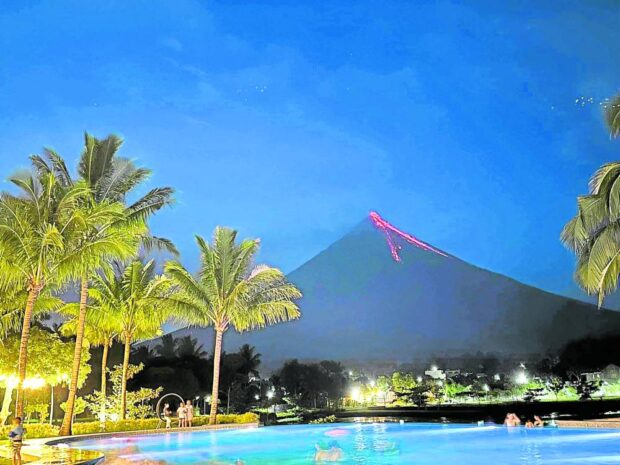
LIVING WITH A RESTIVE VOLCANO | Life goes on for many Albayanos, like this family and its friends who find time to hold a birthday celebration at a resort in Daraga town on June 23, 2023, against the backdrop of a lava-spewing Mayon Volcano. (Photo contributed by ROSEMARIE LOMA)
LEGAZPI CITY, Albay, Philippines — Restive Mayon Volcano has so far emitted an estimated 7 million cubic meters of volcanic materials that could be mobilized as lahar during heavy rainfall, the Philippine Institute of Volcanology and Seismology (Phivolcs) warned on Sunday.
Paul Karson Alanis, Phivolcs’ resident volcanologist in this city, said the debris composed of lava, rocks and ash were more concentrated along the Bonga gully in Legazpi City, Mi-isi gully in Daraga town and Basud gully in Sto. Domingo town.
Alanis said scattered ash were also noted in other quadrants of the volcano.
Jose Marcel Laud, chief science research specialist of the Mines and Geosciences Bureau (MGB) in Bicol, said the about 350,000 dump trucks of debris would still be considered as loose materials and could be easily carried down to the slopes by the rainwater.
“If we compare it to the previous eruptions, this is not yet voluminous because most of the emitted materials were lava flow. But since other materials were loose, it can possibly be mobilized by rainwater compared to the old deposits that were also solidified,” Laud said in a phone interview on Sunday.
He said threatened areas were the villages at the foot of the volcano in the towns of Camalig, Daraga and Sto. Domingo, and Legazpi City.
Continuous emission
Phivolcs on Sunday reminded the public that heavy rainfall could generate channel-confined lahar and sediment-laden streamflows where the deposits were emplaced.
Jaime Bordales Jr., the weather specialist of the Philippine Atmospheric, Geophysical and Astronomical Services Administration in Southern Luzon, said the local thunderstorm would trigger light to moderate rains only in the province.
“In terms of intensity, sometimes it’s heavy but the duration is not that significant, usually maximum of two hours or sometimes 30 minutes to one hour with lightning and thunder,” Bordales said in a phone interview on Sunday.
In the latest bulletin, Phivolcs said the “very slow effusion” of lava advanced to 2.7 kilometers in Mi-isi Gully and 1.3 km in Bonga Gully.
The collapsed debris has been deposited about 4 km from the summit crater of the volcano.
On June 30, Phivolcs released a notice of increased activity in the volcano as pyroclastic density currents (PDC) were also noted in Basud gully in Sto. Domingo, within 3-4 km from the crater. Ashfall from the PDC had been reported by residents in Tabaco City on the same day.
“The other gullies might have been full, so it was redirected to [the] other gully,” Alanis said in a phone interview on Sunday.
CREEPING DANGER | Lava and collapsed debris creep down the slopes of Mayon Volcano on July 2, 2023, as seen in this photo taken from Legazpi Boulevard in Legazpi City, Albay. (Photo contributed by DENNIS MIRABUENO)
Preparation
Tim Lawrence Florece, Camalig’s municipal information officer, said by phone on Sunday that about 5,000 families from 21 villages near the channels and flood-prone areas would be affected in case of a lahar flow.
Florece said they started their information drive, reviewed the contingency plan, and alerted the barangay response teams to prepare the families who have yet to be evacuated from these areas.
As of Sunday, 908 families or 3,192 people were evacuated from the villages of Sua, Quirangay, Tumpa and Anoling, areas inside the 6-km-radius permanent danger zone (PDZ) of the volcano.
Joy Maravillas, head of the municipal disaster risk reduction and management office of Guinobatan, said an additional 3,000 families would be evacuated from the villages of Masarawag, Muladbucad Grande, Muladbucad Pequeño and Doña Tomasa if lahar flow would persist.
Around 914 families (3,058 people) had been evacuated from Guinobatan’s villages of Tandarora, Maninila and Muladbucad Grande, all near the two big gullies of the volcano.
“We are already prepared, and they were already given instructions, like if the volcano erupts, they know the village where to evacuate,” Maravillas said in a private message on Sunday.
In Sto. Domingo, the residents in villages of Lidong, San Isidro, Fidel Surtida, Sta. Misericordia and San Fernando living within the 7-km extended danger zone were also threatened by lahar flow. Some of these families were brought to shelters on June 12 but were sent home on June 20 as Phivolcs only recommended evacuation of residents within the 6-km PDZ.
As of Sunday afternoon, 5,749 families (20,082 people) were evacuated from the towns of Daraga, Camalig, Guinobatan, Malilipot, Sto. Domingo, and the cities of Ligao and Tabaco.
The province had ordered a preemptive evacuation on June 9, a day after Phivolcs raised the alert level 3 over the volcano.